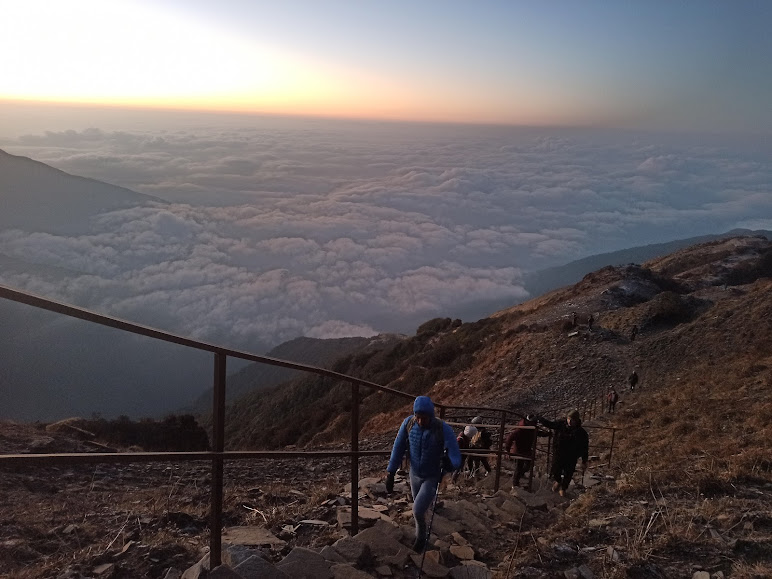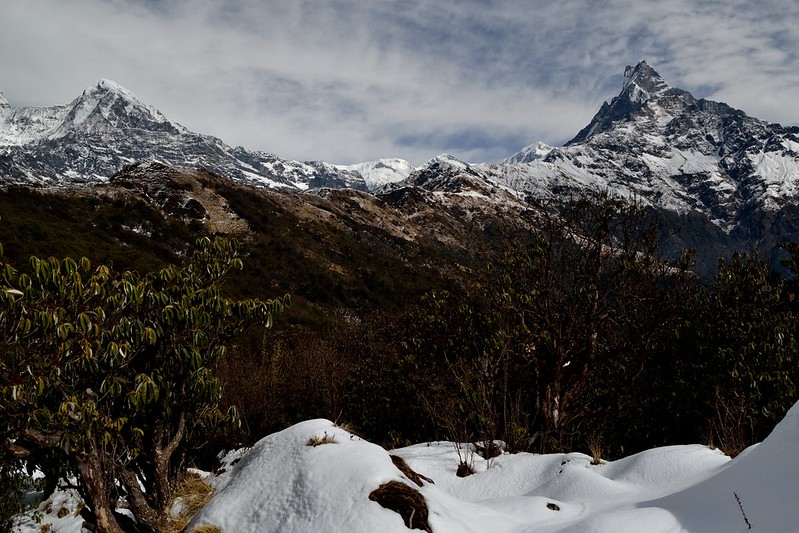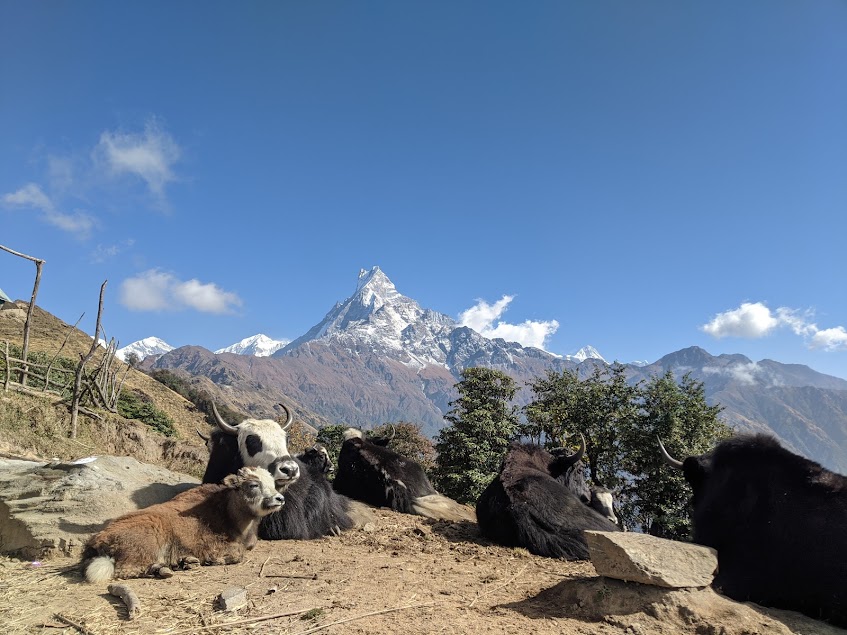Mardi Himal is a hidden trail located on the east side of Annapurna Base Camp. Mardi Himal Trek is a ridge trek offering glorious views of the world’s famous and giant mountains together with Annapurna I (8,091m), Annapurna II (7,937m), Annapurna III (7,555m), Annapurna South (7,219m), Machhapuchre (Mt.Fishtail) (6,993m) Dhaulagiri (8,167m), and Hiunchuli (6,441m).
Mardi Himal Trek is also considered one of the best treks in the Annapurna Region as it takes you through beautiful forested areas to rocky mountain terrain and several base camps which may have snow depending on the season you are trekking. Mardi Himal Trek is the best option for people who are avoiding the crowd, unlike the Ghorepani Poonhill trek. It will take you through a beautiful rhododendron forest at an elevation of around 3,300m through small winding paths.

How difficult is the Mardi Himal Trek?
Mardi Himal Trek is categorized as a moderate to slightly difficult trek. This is a newer trek compared to other famous treks in Nepal offering some of the best views you can have on any trek. People from all age groups can do this trek as there are a lot of factors that contribute to making this trek easy or difficult. Some of the factors that contribute to its difficulty are the duration of the trek, your financial constraints, the route you choose, and many more.

Which month is best for Mardi Trek?
The best season for the Mardi Himal trek is in Autumn (September, October, and November) and Spring(March, April, and May). Mardi Himal Trek can be done from 4 to 7 days and is quite affordable so increasing the number of days that you trek will make it less difficult. The highest point of this trek is 4500 m.

How can I go to Mardi Himal?
You can either start your trek from Kathmandu or Pokhara
Option I:
If you begin your trek in Pokhara, you will drive from your hotel in Pokhara to Kande, where you will begin your journey.
Option II:
If you begin your trek from Kathmandu, you will fly early (first flight) from Kathmandu to Pokhara, drive to Kande, and begin the trek the same day.
Option III:
If you fly back and forth from Kathmandu to Pokhara, you may complete the trek in 5 days from Kathmandu.
What are the trekking routes in Mardi Himal?
Route 1:
If you want to accomplish the Mardi Himal trek in a short time frame like 5 days, the trek starts from Kande hiking to Deurali, then stops at Rest Camp, High Camp, Mardi Himal Base Camp, and finally Siding. Drive back to Pokhara from Siding.
Route 2:
The best-recommended route for the Mardi Himal trek is to start from Kathmandu – Pokhara – Phedi – Dhampus – Australian Base Camp – Forest Base Camp – Low Camp –High Camp –Mardi Base Camp – High Camp – Low Camp – Siding/Lwangghale – Pokhara – Kathmandu. However, the itinerary can be minimized or extended according to your needs.
How do you get to Mardi Himal from Kathmandu?
Traveling Options from Kathmandu to Pokhara
Tourist Bus:
Every day a tourist bus departs from Kathmandu for Pokhara. It takes about 7 hours to complete. Pokhara’s Tourist Bus normally departs at 7:30 a.m.
Private Car/Jeep:
Depending on the size of your group, you can pay for a private car, jeep, or van. It will be more flexible if you hire a private vehicle.
By Air
There are numerous flights from Kathmandu to Pokhara each day. You can take a flight to go there if you choose. From Kathmandu, it takes 25 minutes. It is the most convenient mode of transportation to Pokhara.
Mardi Himal Trek Recommended Itinerary
Day 1: Arrival in Kathmandu
At Tribhuwan International Airport, our representative will meet you. You will be greeted warmly and directed to a hotel that meets tourist standards. In addition, we want to hold a meeting in our office to discuss the upcoming excursion.
Day 2: Fly from Kathmandu to Pokhara followed by a drive to Kande (1 hr) – Pitam-Deurali hike (2100 m) Approximately 2.5 hours
We fly from Kathmandu to Pokhara early in the morning and drive to Kande for approximately an hour on the Pokhara Baglung route. The trek takes roughly 12 hours to reach the crest at 2100 meters. The ‘Australian camp’ is a clearing in the forest with a lodge habitation.
The location is beautiful, with a view of the Annapurna mountain and the Pokhara valley. The route continues through the rhododendron woodland to the ‘Deurali’ mountain pass. Deurali looks out over the Modi Khola valley, which is sandwiched between Annapurna South and Mt Fishtail. In Deurali, we spend the night.
Day 3: Low Camp (2,900m) is a 7-hour trek from the trailhead.
From Deurali, we leave the main Annapurna Sanctuary trail and follow a quiet track to Mardi Himal Base Camp on the right side, passing through a lush forest of oak, maple, hemlock, and rhododendron. After 4 hours of jungle trek, we arrive at Forest Camp, also known as Kokar by the locals, where we stop for lunch before continuing to Low Camp through the forest.
As we rise, the flora changes with more rhododendrons, and the trees are covered in moss, lichen, and tree ferns. There are presently four lodges at Low Camp. You may have a long and difficult day ahead of you. It is good for regular fit trekkers; but, if you are a beginner or moderate trekker, you may divide the day and extend your trek to seven days, rather than the six days we have planned. Low Camp for the night
Day 4: High Camp Trekking (3585m) Trekking takes about 5-6 hours.
We ascend for 1.5 hours through rhododendron woodland to Middle camp, then to Badal Danda, which gives spectacular views of the Mardi Himal, Annapurna South, Hiuchuli, Gangapurna, Machhapuchhre, and the Mardi Himal itself. The path bursts out above the treeline about an hour or so above Low Camp, and there is a fine view of Annapurna South and Hiunchuli to the west.
The route continues along the crest of the Mardi Himal, mostly on grass with a few lonely rhododendron plants. On this portion of the path, keep an eye out for the colorful Danphe pheasant. High Camp’s lodge is bigger than Low Camp and Forest Camp’s lodges, with eight rooms and a separate dining area with a stove. The resort has a fantastic view of Annapurna South, Hiunchuli, and Machhapuchhre (Fishtail).
Day 5: Return to Middle Camp via Mardi Himal Basecamp (4500m) (3200m)
The goal for today is to get up early for a sunrise glimpse of the mountains, then climb up the ridge towards Mardi Himal Base Camp after an early breakfast. There is a well-established route through the grass that has a few higher spots but is not too difficult overall. Look out for Dzokpo (yak/cow crossbreds) and Danphe pheasant feeding up here.
Sheep and goats from lower villages are hauled up to graze in this region during the summer, so you’ll see a lot of herder’s cottages along the path. After three hours, you should arrive at Base Camp at 4500m, where you may get a panoramic view of the Annapurna Sanctuary, including the south face of Annapurna and all of the peaks in the Sanctuary, as well as Hiunchuli and Machhapuchhre (Fishtail). We return to High Camp for lunch before retracing our steps back to Middle or Low Camp.
Day 6: Six hours of trekking to Siding village (1,750m).
On the way back, instead of returning down Mardi Himal to Kokar, we take an alternative path to complete a circuit. From Low Camp, there is a track that leads down to the Siding. Siding is a traditional Nepalese village that is still far apart from the busier contemporary tourist treks.
You will probably stay in a homestay in Siding hosted by someone who owns one of the Low Camp lodges. It’s a fantastic cultural experience to learn more about rural life, and you’ll most likely have dhal baht with the family in their kitchen in the evening.
Day 7: Three hours hike down and 2 hours driving to Lumre and then to Pokhara.
You may walk from Siding to Lumre’s road-head, passing through the settlements of Kalimati and Ghalel on the route. Kalimati is mostly a Brahmin settlement, with mixed Brahmin and Gurung populations in Ghalel and Siding. You will be met in Lumre by a vehicle pre-arranged by Wilderness Excursion to transport you back to Pokhara.
Day 8: Return to Kathmandu by plane.
We travel to the airport in Pokhara after breakfast to catch our flight to Kathmandu. After you arrive at the hotel and refresh up, we will organize a goodbye dinner at one of the restaurants tonight to share your journey experiences.
Day 9: Departure Day
On the last day of your Mardi Himal Trek, before the departure, you might go out and acquire some memories for your loved one. Our company’s private car will transport you to the airport, allowing you to concentrate on your flight time for your final departure. Our representative wishes you a safe voyage and successful onward steps with respect and greetings at the airport.
